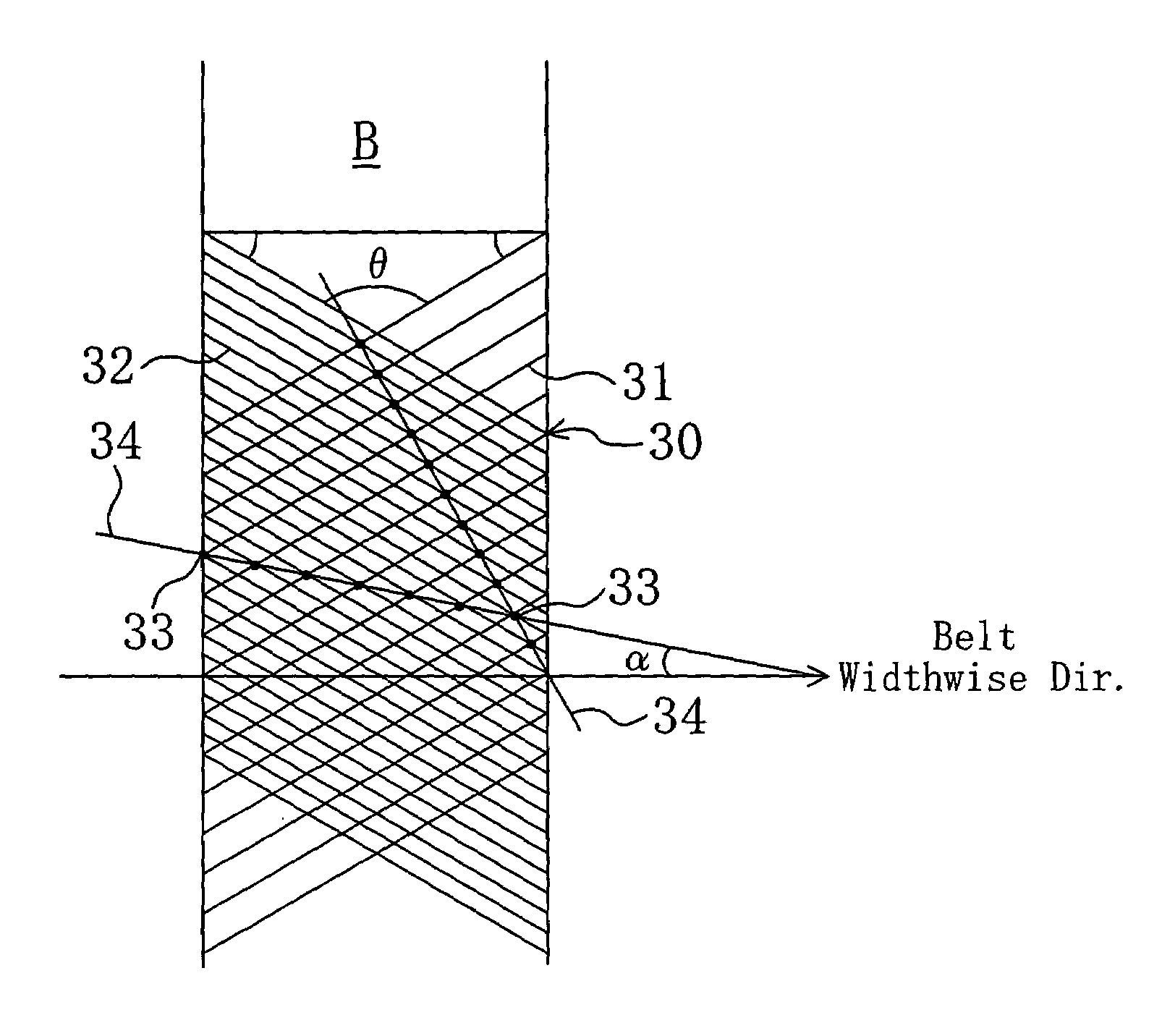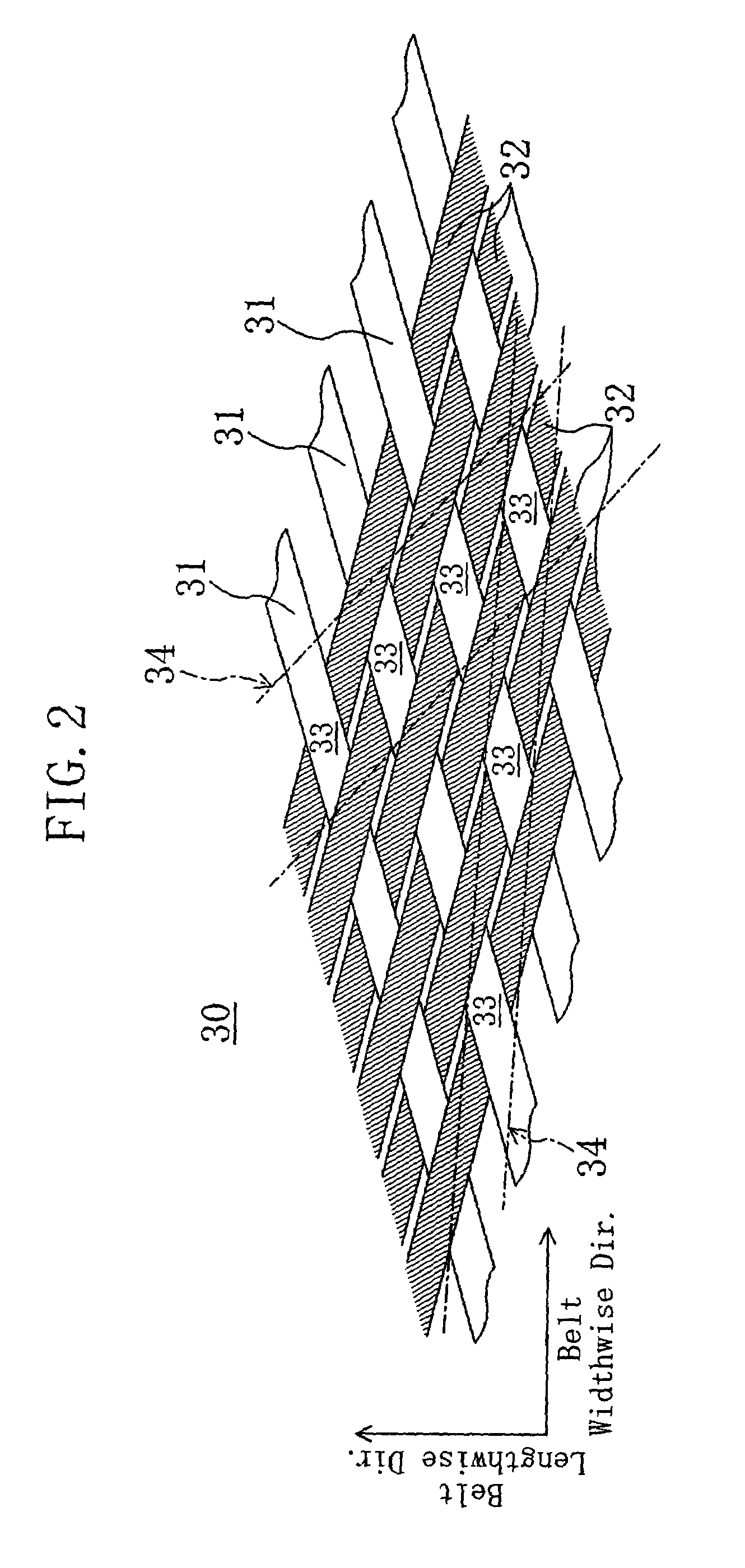Power transmission belt and belt drive system with the same
- Summary
- Abstract
- Description
- Claims
- Application Information
AI Technical Summary
Benefits of technology
Problems solved by technology
Method used
Image
Examples
embodiment 1
[0033]FIG. 1 shows a V-ribbed belt B according to Embodiment 1.
[0034]This V-ribbed belt B has a V-ribbed belt body 10, a cord 20 embedded in the V-ribbed belt body 10 to form a spiral with certain pitches in the belt widthwise direction, and a reinforced fabric 30 disposed to cover the back face side of the V-ribbed belt body 10.
[0035]The V-ribbed belt body 10 is made of a rubber composition such as chloroprene rubber (CR) or ethylene propylene diene monomer rubber (EPDM). The V-ribbed belt body 10 has a structure in which an adhesion rubber layer 11 containing the cord 20 embedded therein, a rib rubber layer 12 located under the adhesion rubber layer 11, and a tension rubber layer 13 located over the adhesion rubber layer 11 to form a back face part of the belt are stacked into one. The rib rubber layer 12 located at the inner periphery side of the belt forms a part for coming into contact with the pulley to transmit power directly thereon. Therefore, in the rib rubber layer 12, ri...
embodiment 2
[0046]FIG. 5 shows the back face of a V-ribbed belt B according to Embodiment 2. Note that the same reference characters refer to the same parts as in Embodiment 1.
[0047]As shown in FIG. 6, the reinforced fabric 30 of the V-ribbed belt B is formed of a rib weave fabric produced so that the angle formed by the directions of each pair of warp 31 and weft 32 is 100° or more (its supplementary angle is 80° or less). To provide the reinforced fabric 30 with the property of adhesion to the V-ribbed belt body 10, it is subjected, prior to molding, to a series of treatments of soaking into a resorcinol-formaldehyde latex (RFL) liquid and heating, a series of treatments of soaking into a rubber cement and drying, a series of treatments of coating a rubber cement to its surface to be in contact with the V-ribbed belt body 10 and drying, or any possible combinations of them. The rib weave fabric forming the reinforced fabric 30 is woven in weft rib weave that has a pattern in which the wefts 3...
example 1
[0059]As a reinforced fabric, use was made of a plain weave fabric which is formed of mutually crosswise (β=90°) running warps and wefts each made by twisting two 300-dtex polyester / cotton blended yarns and has a warp yarn density of 90 yarns / 5 cm and a weft yarn density of 50 yarns / 5 cm. A V-ribbed belt of EPDM (having seven ribs) was fabricated as Example 1 by covering the belt back face with the reinforced fabric so that each of the directions of the warp and the weft makes an angle of 45° with the belt widthwise direction. In the back face of Example 1 V-ribbed belt, between angles that two directions of consecutive yarn intersections of the warps and wefts formed to stand out from the belt surface, i.e., two directions in which lines of bulges formed of the yarn intersections extend, make with the belt widthwise direction, the smaller angle (α) was 7°, and the pitch of the lines of bulges was 0.86 mm.
PUM
| Property | Measurement | Unit |
|---|---|---|
| Angle | aaaaa | aaaaa |
| Angle | aaaaa | aaaaa |
| Angle | aaaaa | aaaaa |
Abstract
Description
Claims
Application Information
 Login to View More
Login to View More - R&D
- Intellectual Property
- Life Sciences
- Materials
- Tech Scout
- Unparalleled Data Quality
- Higher Quality Content
- 60% Fewer Hallucinations
Browse by: Latest US Patents, China's latest patents, Technical Efficacy Thesaurus, Application Domain, Technology Topic, Popular Technical Reports.
© 2025 PatSnap. All rights reserved.Legal|Privacy policy|Modern Slavery Act Transparency Statement|Sitemap|About US| Contact US: help@patsnap.com



